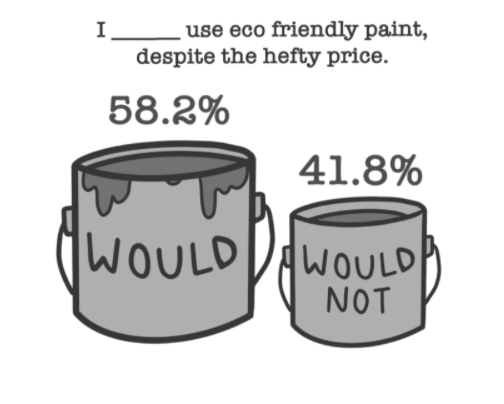Eco-friendly paint offers a safer solution for artists

BLOT GRAPHIC BY VIOLET LONGBONDS
A survey of 55 students from April 6 to April 13.
June 17, 2021
BSN Sports released a collection of vibrantly-colored animal toys for young children in 2017. A year later, they were forced to recall these seemingly harmless novelties because they contained lead paint.
Even though lead paint was banned decades ago, it still poses a hazard in modern products. While most other paints don’t contain this harmful chemical, they can still be dangerous.
In many acrylic paints, a synthetic plastic known as acrylic polymer emulsion binds pigment particles together. This may not sound harmful, but when artists pour their paint water down the drain or throw their paints away, their materials could contribute to ocean or landfill pollution.
Some paints may also emit dangerous gases. Acrylic and oil-based paints often use volatile organic compounds (VOCs) so that they can spread easily. However, once they dry, these VOCs evaporate and can contribute to smog, a type of fog containing dangerous air pollutants. In poorly ventilated spaces, artists can experience dizziness, headaches and even nausea if they inhale these fumes for too long, especially those from oil paints.
Some have even considered certain hues to be dangerous. Colors made with the element cadmium, such as cadmium red and cadmium yellow, contribute to pollution and pose a potential health risk if artists inhale too much. These findings nearly led to the European Union banning the hues in 2015.
Junior David Pietras of Marlboro feels that the environmental impact of paint is often overlooked.
“I feel like this is an issue that isn’t really brought up,” Pietras said. “People talk about eco-friendly things but paint is less of an issue I see popping up, so I think it’s definitely something that needs to be changed more.”
Instead of using harmful paints, some artists have turned toward making their own. Acrylics, oils and watercolors can be produced with all sorts of natural materials, including ash, dirt, vegetables and even human spit.
Many artists have taken to social media to film their paint-making process, from foraging for materials in nature to mixing natural pigments into solvents with a palette knife.
If making paint seems like too much of a hassle, numerous online stores offer different types of paints made from natural materials. One popular Etsy store, Poems About You, sells a wide variety of environmentally friendly watercolor paints. Art YouTuber Sara Tepes acknowledged that the paints are expensive, but claims that they work just as well as traditional paints.
“My order of 12 colors was $101, which is pretty pricey,” Tepes said. “However, these are really high-quality colors.”
Freshman Niken Patel of Ocean believes that regardless of their price, natural paints prove to be a good solution to store-bought paint’s environmental impact.
“The ingredients in [eco-friendly paint] are pretty natural and do seem better than man-made chemicals,” Patel said. “Natural paints sound like a good alternative.”
Pietras agrees that natural paints can be beneficial, noting that these materials were once commonplace.
“Artists way back then would use natural things like vegetables and plants,” Pietras stated. “We kind of geared more towards artificial stuff and I feel like going back towards more natural stuff is a good way to go because we’ve been doing that for a while.”




